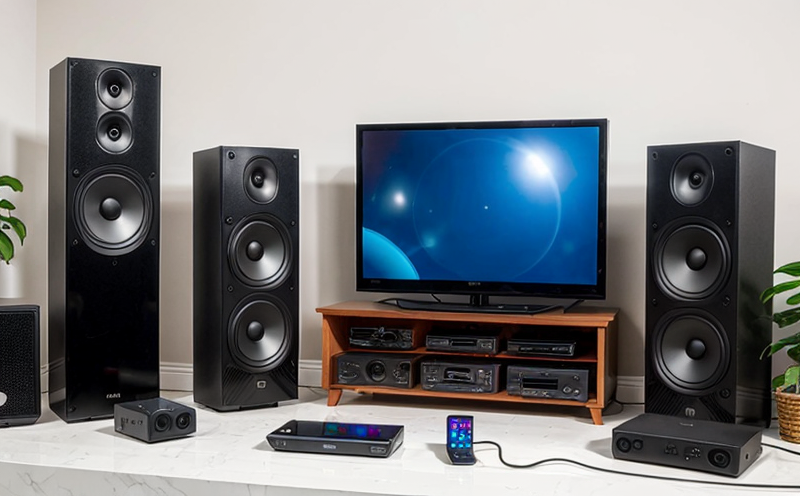ANSI C63 4 EMC Testing for Consumer Electronics
The ANSI/IEEE Standard C63.4-2018 specifies limits and methods of measurement for electromagnetic compatibility (EMC) emissions from consumer electronics devices. This standard is crucial because it ensures that electronic products do not interfere with other devices, maintain their performance in a specified environment, and comply with regulatory requirements.
Compliance with ANSI C63.4-2018 is essential for manufacturers of consumer electronics to ensure interoperability within the market and prevent potential issues during product design or after launch. The standard covers emissions from devices operating at frequencies ranging from 10 kHz up to 1 GHz, which are critical for modern electronic products.
Manufacturers must conduct tests according to this standard to demonstrate compliance with electromagnetic compatibility (EMC) requirements. This testing is a regulatory requirement in many countries and regions around the world. Properly conducted EMC testing ensures that consumer electronics function reliably without causing or being affected by interference from other devices, which is particularly important for products like home theater systems, smartphones, and smart speakers.
The test procedure involves measuring the radiated emissions of electromagnetic signals from a device under test (DUT) within specified frequency bands. The DUT is placed in an anechoic chamber to minimize external interference and ensure accurate measurement results. The testing is typically conducted at various angles around the device to capture all possible emission directions.
Compliance with ANSI C63.4-2018 also ensures that consumer electronics devices can operate effectively within the electromagnetic environment they will encounter in real-world conditions, such as homes or offices. This includes the presence of other electronic equipment and potential interference from power lines, radio signals, and other sources.
Testing according to ANSI C63.4-2018 is essential for manufacturers who want their products to meet regulatory requirements and avoid costly recalls or product failures due to EMC issues. It helps ensure that devices perform consistently across different regions and environments, enhancing consumer satisfaction and trust in the brand.
The standard also provides a framework for ongoing improvements in electromagnetic compatibility design by offering detailed measurement procedures and acceptance criteria. This allows manufacturers to refine their products continuously, ensuring long-term compliance and reliability.
Scope and Methodology
| Parameter | Description |
|---|---|
| Frequency Range | 10 kHz to 1 GHz |
| Emission Limits | Compliance with IEC 62537-1 and -2 |
| Measurement Setup | Anechoic chamber, calibrated antenna |
| Data Processing | FFT analysis for spectral density |
The ANSI C63.4-2018 standard specifies that all consumer electronics devices must meet emission limits at specific frequencies within the 10 kHz to 1 GHz range. The testing setup includes an anechoic chamber, a calibrated antenna, and a spectrum analyzer for accurate measurement of emissions.
Data processing involves Fast Fourier Transform (FFT) analysis to determine the spectral density of the emitted signals. This process helps identify any potential interference issues that could arise from the device's operation within the specified frequency range.
Compliance with ANSI C63.4-2018 ensures that consumer electronics devices do not cause or suffer from electromagnetic interference, which is critical for maintaining high-quality performance in a crowded technological environment. The standard provides detailed instructions on how to conduct these tests accurately and consistently across different manufacturers and models.
Why Choose This Test
- Ensures compliance with international standards (ANSI/IEEE C63.4-2018)
- Achieves regulatory requirements in multiple countries
- Enhances product reliability and interoperability
- Prevents costly recalls due to EMC issues
- Maintains high-quality performance across diverse environments
- Supports continuous improvement in electromagnetic compatibility design
- Ensures long-term compliance with changing regulatory landscapes
- Promotes consumer trust and satisfaction
Selecting ANSI C63.4-2018 EMC testing is beneficial for manufacturers who want to ensure their products meet rigorous standards and avoid potential issues during production or after launch. This test provides a comprehensive approach to evaluating the electromagnetic compatibility of consumer electronics, ensuring that devices operate reliably without causing or suffering from interference.
By choosing this test, manufacturers can demonstrate their commitment to quality and regulatory compliance, which is essential for building a strong reputation in the market. It also ensures that products are ready for deployment in various environments, enhancing user experience and satisfaction.
International Acceptance and Recognition
The ANSI/IEEE Standard C63.4-2018 is widely recognized and accepted internationally as a key standard for EMC testing of consumer electronics devices. This standard is adopted by countries around the world, including the United States, Canada, Europe, and Asia-Pacific regions.
Many regulatory bodies use this standard to ensure that electronic products meet electromagnetic compatibility requirements before being sold in their respective markets. For example, the FCC (Federal Communications Commission) in the U.S., CEPT (Common Regulatory Framework for European Telecommunications), and MIC (Ministry of Industry and Information Technology) in China all reference ANSI C63.4-2018 as a key standard.
The international acceptance of this standard ensures that products comply with global regulatory requirements, reducing the need for separate testing in different regions. This simplifies the process for manufacturers who want to sell their products internationally, as they only need to conduct one set of tests to meet all relevant standards.
By adhering to ANSI C63.4-2018, manufacturers can ensure that their consumer electronics devices are compatible with a wide range of environments and other electronic equipment. This is particularly important for products like home theater systems, smartphones, and smart speakers, which are increasingly used in diverse settings.
The standard's global recognition also promotes consistency across different regions, ensuring that products perform reliably wherever they are sold. This helps to build trust with consumers who expect their devices to work seamlessly in various environments.





